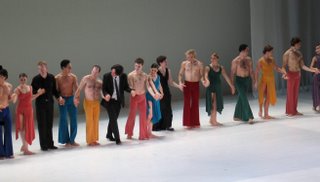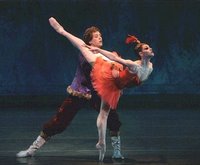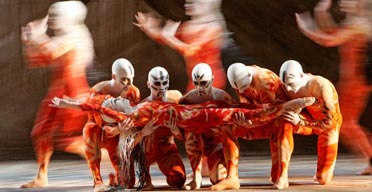The
Washington Ballet is back on its feet, presenting two world premieres united under a title “Bach/Beatles Project” at the Kennedy Center’s Eisenhower Theater. “How wonderful to be back in the studio!” remarked Artistic Director of the Washington Ballet Septime Werbre before the curtain rose after the newly negotiated labor contract finally put an end to a lengthy period of cancellations, uncertainty, and unemployment for the company’s 20 dancers, returning them on stage.The first part of the program, “State of Wonder,” was set to Bach’s
Goldberg Variations. Septime Webre choreographed a spectacle of 32 intricate miniature dances to the arias, 29 variations and the Quodlibet, some of them lasting less then two minutes. The program unfolds in three sections or acts. The first act was accompanied by Glenn Gould’s early recording (where he plays it fast, faster, and very fast) and began with a solo performance by Jonathan Jordan to the ever gorgeous aria. And then variations began: variations in music, tempi, costumes, and choreography. Costume designer “Vandal” outfitted the entire troupe in identical (and not-very-appealing) skimpy gray outfits: little shorts and shirts. (I thought it made dancers looked like Charles Dickens’s Oliver Twist orphans in their sleepwear.).

With dazzling speed the dancers appeared on stage, twisting and turning their bodies, rotating each other, and leaping in the air; men lifting, throwing, and catching men; men lifting, throwing, and catching women… They were gymnasts, acrobats, runners, figure skaters, martial artists, and ballroom dancers. At their best, their performance was electrifying and technically near flawless. Dancing in threesomes (Variation 6) demonstrated that the extra pair of helping hands makes lifting and spinning ladies in the air look remarkably effortless. A golden girl of the Washington Ballet, gorgeous Michele Jimenez, was very effective in duets with Luis Torres and Morgann Rose. Her polished movements, breathtaking extensions, and absolutely astonishing flexibility made her a centerpiece of the show. [According to
The Washingtonian, Jimenez will leave Washington for the Dutch National Ballet in August. -- CTD] During the first ‘intermission’ two quartets of the dancers rolled a harpsichord on stage (with harpsichordist Scott Dettra) and a piano (with a pianist Ralitza Patcheva), in what appeared to be a waltz of these two instruments. After a little dance, the piano left the stage and gave place to the instrument Bach would have had at his disposal.
The second act brought a change in tempi and clothes: slower, dotted with colored skirts and dresses for the corps, which proved easier on the eye than their original mouse-colored underwear. The slower music transformed the nature of the choreography: dances became more sensual and amorous. One of the most memorable performances in the harpsichord part was a love-duet by Laura Urgelles and Jonathan Jordan in a traditional classical ballet movement set to Variation 21. Their performance had so much elegance and tenderness, one didn’t want this dance to end. The martial arts scene completed the second act and the piano returned on stage. Men changed skirts to colored pants and the women's dresses acquired more sophisticated design. As music became slower so did the pace of the dances: in the beginning of the third section it was almost like watching a movie played at a very slow speed. It all changed when Jason Hartley and Jonathan Jordan flew on stage, proving wrong anyone who says “White men can’t jump.” The Aria Da Capo fluently danced by Jason Hartley completed the Bach program. Webre’s Variations received a warm approval from the audience.

After the intermission it was a Beatles-hit-parade. Choreographed by very-much-in-demand Washington Ballet resident choreographer Trey McIntyre, this ballet was titled “Always, No Sometimes.” It was a concert and a dance performance altogether starring John Lennon and Jason Hartley. Dressed in all white by costume designer Liz Prince, the Washington Ballet showcased McIntyre’s innovative and compelling approach to modern dance. The Beatles if singing today couldn’t have asked for better staged and executed backup dancing.

“Successful choreography uses the inherent beauty of the ballet vocabulary to meaningfully engage the audience, creating the opportunity to connect to the human experience. My work explores the beauty of that experience,” said choreographer in his artistic statement. He created “The 12 Beatles dances” right in the studio working with performers one-on-one. “Think creatively. Let your body react emotionally, make it more sensual” – his advice to a successful interpretation of his ideas. And he does have many original and innovative ideas that make his choreography so novel and engaging. From more than 200 songs recorded by the Beatles, the choreographer made a selection of songs with different melodic traits: from dreamy “Mother Nature’s Son” and romantic “Blackbird” to jazzy “Ballad of John and Yoko” and happy “Ob-la-di, Ob-la-da.” The company’s principal dancer Jason Harley truly shined through the entire performance exhibiting impeccable technique and musicality. At the end of the program he rightfully received the loudest “Bravos” from the audience. Michele Jimenez was mesmerizing in her marionette-like dance set to a John Lennon’s song “Julia.” This program will be enjoyable to watch not only for ballet lovers but also for everyone who has a personal connection to the Beatles music.

As the curtain went down, the audience stood up rewarding the performers and creators of the “Bach/Beatles Project” with a standing ovation. If anyone had doubts about the future of the Washington Ballet, after this program, it’s obvious -- the company is back in business. Hopefully for Always, No(t) Sometimes.
The repeat performances are tonight at 8pm, Saturday at 2:30pm & 8pm and Sunday at 1pm & 5pm.













